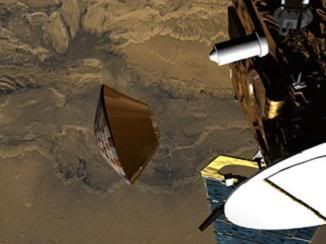Post by glactus on Mar 23, 2008 21:18:23 GMT

The Beagle 2 lander - devastating loss
To date, 26 of the 43 missions to Mars, that's a whopping 60%, have either failed or only been partially successful in the years since the first Marsnik 1 attempt by the Soviet Union in 1960.
In total the USA/NASA has flown 20 missions, six were lost - 70% success rate. The Soviet Union/Russian Federation flew 18, only two orbiters, Mars 2 and 3 were a success - 11% success rate. The two ESA missions, Mars Express, and Rosetta fly-by were both a complete success. The single Japanese mission, Nozomi, in 1998 suffered complications en-route and never reached Mars; and the British lander, Beagle 2, famously went AWOL in 2003.
Admittedly, Mars has drawn more space missions than the rest of the Solar System's planets, but why have nearly two thirds of all Mars missions failed in some way?
Is the "Galactic Ghoul" or the "Mars Triangle" real? Or is it a case of technological trial-and-error? In any case, the Mars Curse has been a matter of debate for many years, but recent missions to the Red Planet haven't only reached their destination, they are surpassing our wildest expectations. Perhaps our luck is changing…
To travel from Earth to Mars takes over a long seven months, then the craft has to separate from its orbiter, re-enter the Martian atmosphere and make a soft landing. This would be a huge technological success in itself - considering that it may get blown over by a dust storm - an ultimate example of bad luck, but it can happen. Fortunately, both the Mars 2 and 3 orbiters completed their missions, relaying huge amounts of data back to Earth.

Mars geologists
credits:
This is part text only. See image, full text and all scientists involved at universetoday.com
www.universetoday.com/2008/03/22/the-mars-curse-why-have-so-many-missions-failed/#more-13267
Beage 2 image:
www.universetoday.com/wp-content/uploads/2008/03/beagle2.jpg
article credit: Ian O'neill



